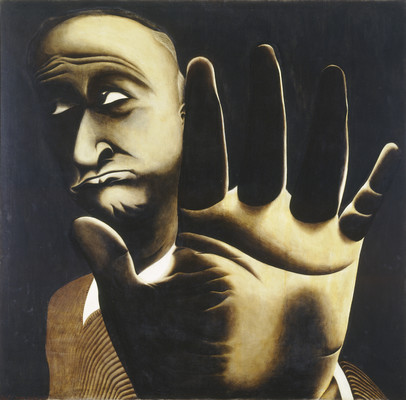B.
No! by Tony Fomison
Collection
No! was begun in 1969 while Tony Fomison was living in a house in Riccarton Road with Philip Clairmont and other bohemian artists. Typical in its intensity and edgy mood, this work was inspired by a newspaper photograph Fomison saw when he was in England during the late 1960s.

Tony Fomison No! 1971. Oil on canvas. Collection of Christchurch Art Gallery Te Puna o Waiwhetū, purchased 1973. Reproduced with permission
Fomison often found his subject matter in almost chance discoveries of photographs or illustrations. Although the painting is from the newspaper photograph it is not specifically about the subject of the report and circumstances that the photograph depicts. Rather, Fomison has adapted the man's head and violent gesture into an archetypal expression of negativity and lack of communication. There are no words, the mouth is shut and obscured by the hand and eye contact is withdrawn. Pulled right onto the front plane of the painting the huge hand is thrust forward virtually into the viewer's face. Fomison's images are an expression of the artist's inner world with archetypal symbols which stand for humanity's continuing predicaments. Here he seems to be focused on the problems of interpersonal communication.
Fomison's style is economic and expressive, often simplifying his subjects into grim and unsettling caricatures. He was greatly influenced by the works of European master painters such as Caravaggio (1571 -1610) and Domenico Ghirlandaio (1449 -1494), but his works were always driven by his own distinctive, and often eerie creative vision. Fomison saw himself as an outsider and his work frequently explored that theme. Following time spent in institutions, Fomison became fascinated with painting prisoners and people with disfigurements or diseases or outcasts in the community. Part of a series of portraits, many of prison inmates, this work is typical in its intensity and edgy mood and uses a style he developed overseas: "I had found a way of painting derived completely from my drawings." The hand and face are painted in almost monotonal black and white with subtle umbers, that create a wide range of dark hues. Although the composition is built up from numerous thin layers of paint Fomison leaves no visible brush marks.
The former Robert McDougall Art Gallery's purchase of this work in 1973 was the first-ever institutional acquisition of Fomison's work and at the time, No! was the biggest painting completed by Fomison, who remains one of New Zealand's most original artists.
Anthony Leslie Fomison was born in Christchurch in 1939. He attended the University of Canterbury between 1957 and 1960, studying sculpture. While he was studying at University, Fomison became involved in the excavation of a Maori archaeological site in Redcliffs and later joined expeditions led by Roger Duff and worked for him in the Canterbury Museum Ethnology Department. He recorded the Maori rock drawings he observed in caves and shelters scattered throughout the South Island by making traces of the ancient drawings. This began his lifelong interest in Maori and Polynesian cultures, which he often incorporated into his work.
Travelling to England and Europe in 1963 on an Arts Advisory Board grant, Fomison was influenced by the Old Masters but produced very little work at this time. He joined a street gang while in Paris, surviving on his wits and money gleaned from chalk drawings on pavements, but was arrested for vagrancy and spent three weeks in La Sante prison. Once back in London Fomison worked during the day and tried to paint at night, but found the stress to be too great. He was admitted to London's Banstead Hospital where three months forced rest enabled him to resume his painting. Following his return to New Zealand in 1967, Fomison moved to Christchurch and worked with the Canterbury Society of Arts. In 1971 he had a large solo exhibition at the CSA that included No! and other paintings depicting concentrated forms strongly modelled in black and white. Living in Auckland during the 1970s, he developed a range of imagery that drew on Polynesian myths and legends and images from his own imagination. Fomison was the first recipient of the Rita Angus Fellowship in 1985. He died in Whangarei in 1990.
Jennifer Hay

